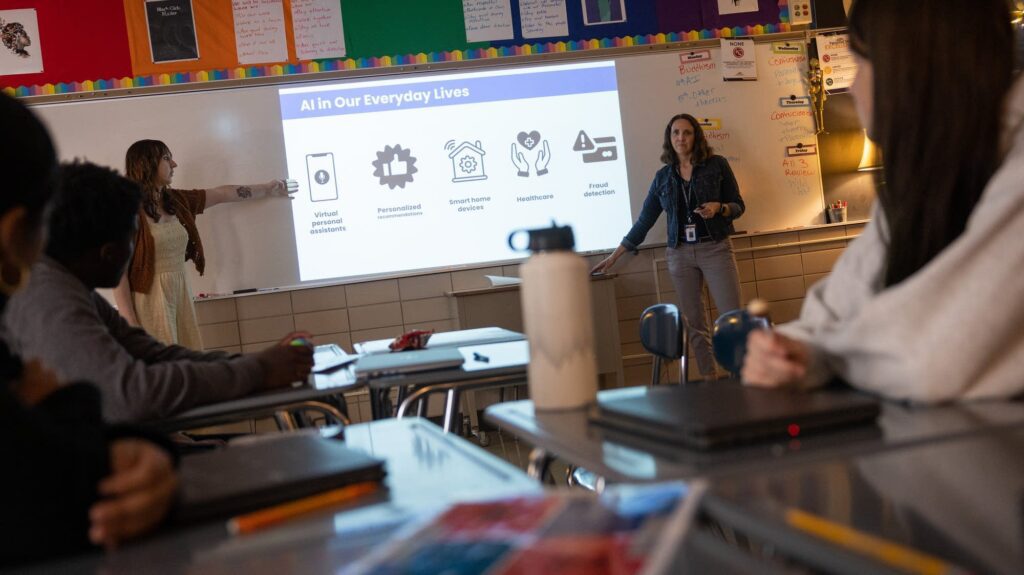Embracing AI in Education: A New Era at Kennedy High School
Typically, psychology lessons fill the minds of students in room 314 at Kennedy High School on Monday mornings. However, a recent class took a different turn, pivoting away from humans to explore machine behavior. Teachers Rowen Elsmore and Jodi Bang introduced students to ChatGPT, an innovative artificial intelligence tool designed to generate and organize information simply by asking it questions.
Exploring AI: A Hands-On Experience
"Today, we’re learning to use AI as a thought partner," Elsmore, a digital learning specialist, explained to the class. The objective of the session was straightforward: educate students on how the AI operates and encourage them to experiment with its capabilities and constraints. “This tool can either enhance your learning or hinder it, depending on how you approach it,” he added.
Students quickly signed into ChatGPT, engaging in fun activities that involved pulling jokes from the AI and assessing its responses to questions, particularly noting instances where the AI generated incorrect information. Elsmore encouraged students to reflect on their experiences, emphasizing the variability in outcomes based on the questions posed and the manner in which they were articulated.
The Changing Landscape of Education
Experts assert that artificial intelligence has the potential to revolutionize learning in ways akin to the internet’s impact three decades ago. Yet, schools nationwide often regard this technology with skepticism, prompting some large districts to restrict student access due to concerns about its implications.
In Bloomington, however, educators are adopting a constructive stance towards AI, guiding students in navigating the technology while also discussing its potential pitfalls—akin to a driver’s education approach for artificial intelligence.
“These are essential skills for students,” stated Alexandra Holter, the district’s computer science coordinator. “We made a conscious choice last year to delve into AI and explore its role in education—enhancing engagement for both students and staff.”
A State of Transition
Despite its promise, Minnesota currently ranks last in the nation for offering computer science education, with only 28% of public high schools in the state providing such classes. As of now, there are no statewide standards for teaching AI, although new literacy standards will require students to learn how to safely access, analyze, and create digital content. Therefore, as schools like Bloomington forge ahead, they remain in a crucial transition phase regarding technology integration.
During discussions at Kennedy High, students exhibited varied levels of enthusiasm regarding AI. For junior Jay Crenshaw, this was his first experience with ChatGPT. While he previously considered classmates’ use of AI merely an “extra” resource, he quickly recognized its potential, especially for coding help in his robotics class. Crenshaw also voiced the necessity for more guidance on using AI safely, highlighting the perils of misinformation online.
Conversely, junior Mischa Campos-Taylor, who has taken several computer science classes, frequently utilizes ChatGPT to clarify difficult concepts. “It’s a helpful resource when my teacher isn’t around; I can use it to understand things better without feeling like I’m bothering anyone,” she remarked.
The Road Ahead
Bloomington’s digital learning specialists are committed to helping educators harness AI effectively in the classroom, translating lessons into multiple languages, providing feedback, and generating project ideas. The learning process is mutual; educators, too, glean insights from students.
“We often underestimate the capabilities of our students,” Holter noted. “They demonstrate remarkable thoughtfulness when interacting with new technologies.”
Young Learners and AI Literacy
Last year, the Brookings Institution reported that public schools are choosing among three strategies regarding AI: outright bans, curriculum integration, or careful review. The report encourages schools to adopt the latter two approaches, framing AI as a tool for educational assistance rather than a threat.
Statewide, even elementary students are getting in on the action. At Harriet Bishop Elementary in Savage, fourth graders are introduced to age-appropriate AI tools like SchoolAI. Shonita Harper, a digital learning specialist, emphasizes the importance of critical thinking, helping students evaluate whether digital images are genuine or altered.
“My goal is to cultivate creative communicators and responsible digital citizens,” she shared. “I want them to use their online powers for good.”
Conclusion
As educational institutions navigate this rapidly evolving technological landscape, embracing AI in a meaningful way seems vital for preparing students for the future. By equipping young minds with tools and knowledge about AI, educators can help foster a generation capable of leveraging technology responsibly and creatively.
The AI Buzz Hub team is excited to see where these breakthroughs take us. Want to stay in the loop on all things AI? Subscribe to our newsletter or share this article with your fellow enthusiasts.




